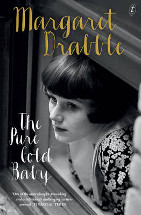The pure gold baby by Margaret Drabble

Text, 2013. ISBN 9781922147516.
(Age: 15+) Recommended. In Margaret Drabble's latest novel, The
pure gold baby, the central concern is the relationship
between Jess, a single mother, and her daughter Anna, the pure gold
baby who is always happy but has an intellectual disability. Told by
the first person narrator, one of Jess's friends, the story begins
when Jess, an anthropologist, sees children with SHSF (either fused
fingers or toes) playing near an African lake. She responds to them
with tenderness, and comes to believe that this sight is a
preparation for her own child's disability. Anna is a beautiful and
sweet tempered baby, but does not develop as other children do. She
cannot learn how to read or write, and as her baby friends grow she
becomes more dependent on her mother and her mother's friends. Jess
develops professionally, writes and studies, and maintains her
friendships, even marrying, but increasingly the central
relationship of her life is with her daughter. Drabble demonstrates
the dilemma facing all parents of permanently dependent children.
Should Jess put Anna into care? Should she live in sheltered
accommodation? Jess tries a boarding school for her daughter but
eventually both she and Anna are happier when Anna returns home.
Jess eventually visits Africa again, with Anna, and realizes that
her quiet days at home with Anna are what she now needs most. The
passing of years allows Drabble to deal with another theme, the
changing social milieu. Suburbs change, attitudes to child raising
change, and, most importantly, beliefs about how to deal with
disability and mental illness change. As an anthropologist Jess is
aware of and studies the attitudes of those who try to improve the
lives of others. Missionaries and psychiatrists and their theories
about how best to deal with questions of treatment and care are of
interest to her. Treatments have changed quite significantly since
Anna's birth in the sixties, and there seems to be no one answer.
Jess also maintains contact with those who do not live mainstream
lives, perhaps as models for Anna's future. Drabble's final theme is
that of mortality, of how our values change as we age, and of how
particularly difficult such a process is for a parent with a
dependent and disabled child. Written in measured sentences the book
is easy to read and insightful about both the process of raising a
disabled child, and the role of memory and hope in all lives.
Drabble deals with what happens in her characters' lives but also
tries to give an understanding about why they make the choices they
do. It is recommended for older readers.
Jenny Hamilton